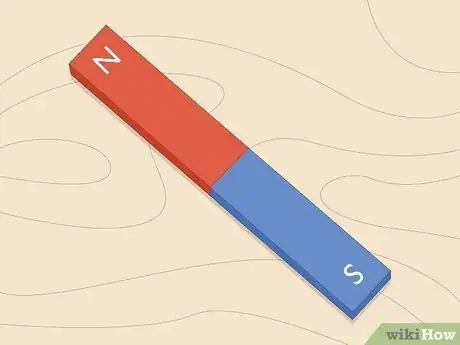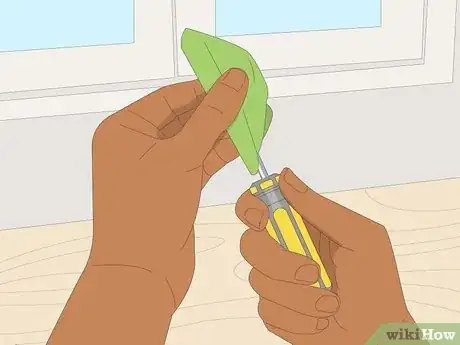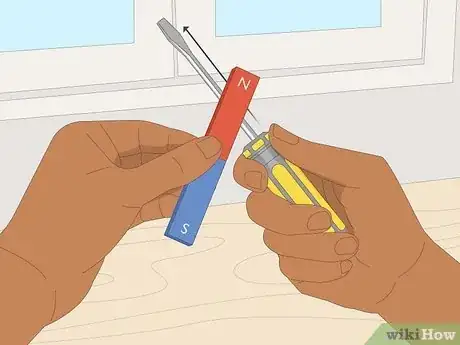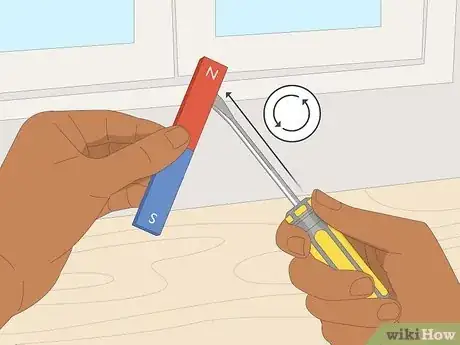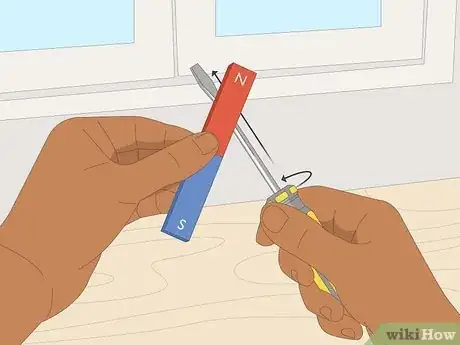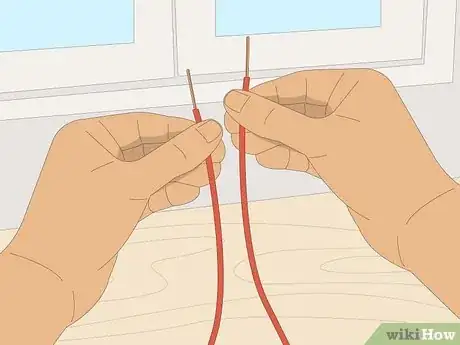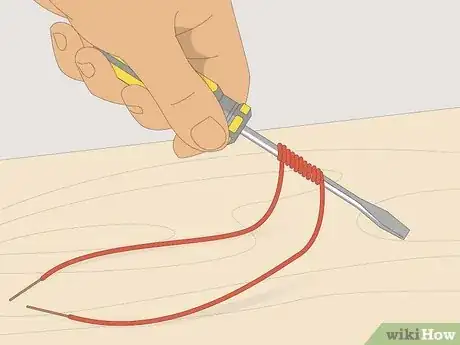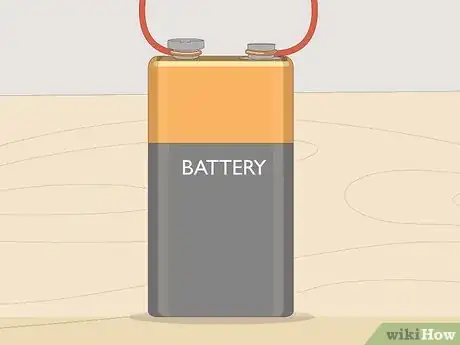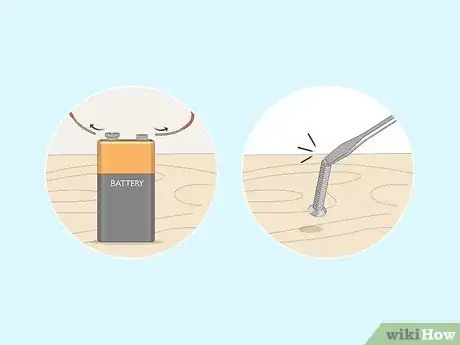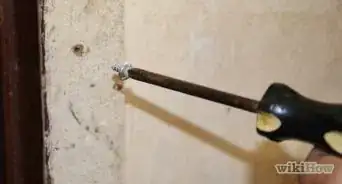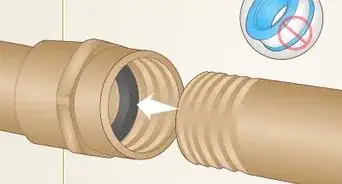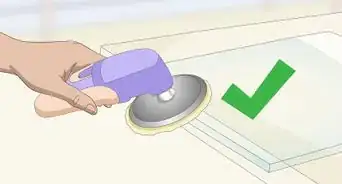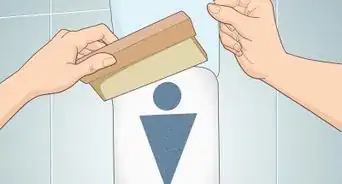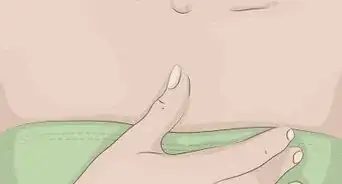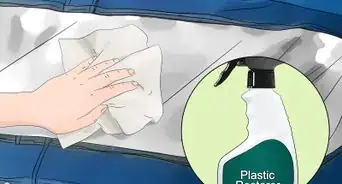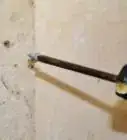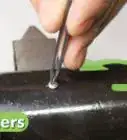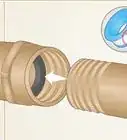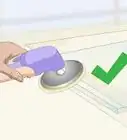This article was co-authored by wikiHow Staff. Our trained team of editors and researchers validate articles for accuracy and comprehensiveness. wikiHow's Content Management Team carefully monitors the work from our editorial staff to ensure that each article is backed by trusted research and meets our high quality standards.
There are 10 references cited in this article, which can be found at the bottom of the page.
wikiHow marks an article as reader-approved once it receives enough positive feedback. In this case, 100% of readers who voted found the article helpful, earning it our reader-approved status.
This article has been viewed 223,811 times.
Learn more...
You know the feeling: your arm crooked into a crevice, the screwdriver barely long enough to reach, and the clatter of a screw slipping down to the floor. Save yourself the pain next time by turning your screwdriver into a long-lasting magnet.
Steps
Using a Magnet
-
1Choose a strong bar magnet. The stronger the magnet, the easier it will be to magnetize the screwdriver. Ideally, find a neodymium magnet or other rare-earth magnet with a pull force of at least ¼ pound.[1] These are available at hardware stores or online.
- If you don't mind destroying an old hard drive, you can disassemble it to get two strong magnets.[2]
-
2Wipe the screwdriver clean. Remove any grime from the screwdriver. If you need to use a damp cloth, dry the tool thoroughly afterward.[3]Advertisement
-
3Slide the magnet from the handle to the tip. Touch one end of the magnet to the metal surface of the screwdriver, next to the handle. Drag it down to the tip. This causes small magnetic regions (domains) in the steel to align in the direction of the magnet's field.[4]
- On a large screwdriver, magnetize the half closest to the tip instead of the whole tool.
-
4Repeat this motion in the same direction. Take the magnet off the screwdriver, then drag it from the handle to the tip again. Repeat this several times, using the same end of the magnet each time.
- Do not drag the magnet back from the tip to the handle. This will undo your work.
-
5Rotate and repeat. Rotate the screwdriver by a quarter turn. Drag the magnet from handle to tip again several times. Repeat with the third and fourth sides of the screwdriver.
-
6Test the screwdriver. If the screwdriver can't pick up a screw magnetically, repeat the process. If it still doesn't work after ten passes on each side, try again with a stronger magnet.
- A hard steel screwdriver can stay magnetized for months. If you'd like to demagnetize it, run the magnet back the other way (tip to handle), or whack the screwdriver against the wall a few times to scramble its magnetic domains again.[5]
Using a Battery
-
1Strip the insulation from both ends of a piece of wire. Cut off a piece of wire at least 3 ft. (0.9m) long, then strip about an inch (2.5 cm) of insulation off each end.
-
2Coil the wire around the screwdriver. Wrap the wire tight around the screwdriver shaft ten to twenty times. You can double back for a second layer if the screwdriver is too short, but don't reverse the direction of the loop. (For example, you can move left—right—left along the screwdriver, but make sure to wind every loop clockwise.) Tape the wire in place if necessary.
-
3Attach the wires to a household battery. Attach the wire ends to the terminals of a 6V or 9V battery. The current flowing through the coils will create a magnetic field, which in turn magnetizes the screwdriver.
- Using higher voltage batteries is not recommended unless you have experience handling them safely. Anything more powerful than a 9 volt battery only needs to be connected for a split second to magnetize the screwdriver.[10] Wear insulated gloves to protect from shocks and sparks.
-
4Disconnect the battery. The screwdriver will always be magnetic while connected to the battery, but the wire and battery terminals will heat up quickly.[11] Disconnect the battery after 30 to 60 seconds, then try to pick up a screw with the screwdriver. In most cases, it will still be magnetic.
- If the screwdriver loses its magnetism after the battery is disconnected, wrap a few more loops of wire and try again.
Community Q&A
-
QuestionCan't I also magnetize it using 2 magnets aligned the same way? I was able to do that with drill bits.
 Community AnswerYou really only need one strong magnet - just rub it along the metal shaft repeatedly, going in the same direction each time. The more times you rub the magnet along the shaft, the stronger its magnetization will be. It should only take a few seconds.
Community AnswerYou really only need one strong magnet - just rub it along the metal shaft repeatedly, going in the same direction each time. The more times you rub the magnet along the shaft, the stronger its magnetization will be. It should only take a few seconds.
Warnings
- Some electronic components can be damaged by magnets. A magnetized screwdriver is usually not strong enough to cause issues, but use it at your own risk.⧼thumbs_response⧽
- Powerful neodymium magnets (including any salvaged from hard drives) can pinch your fingers hard enough to draw blood. Handle with caution.⧼thumbs_response⧽
- Do not use non-insulated wire to connect your screwdriver to the battery. The current will short across the wire instead of producing a magnetic field — and will shock anyone who touches it.⧼thumbs_response⧽
Things You'll Need
Magnet Method
- Screwdriver
- Strong magnet (at least ¼ pound)
Battery Method
- Screwdriver
- 16–22 AWG (1.3–0.6mm diameter) wire
- Wire strippers (or sandpaper for enamel-coated wire)
- Tape
- 9 volt battery
References
- ↑ http://www.bobvila.com/articles/how-to-magnetize-a-screwdriver/#.V9bmnrV2F8A
- ↑ http://blog.first4magnets.com/how-to-get-neodymium-magnets-from-a-hard-drive/
- ↑ http://www.bobvila.com/articles/how-to-magnetize-a-screwdriver/#.V9bmnrV2F8A
- ↑ https://www.nde-ed.org/EducationResources/HighSchool/Magnetism/magneticdomain.htm
- ↑ http://www.popularmechanics.com/cars/how-to/a4755/4334647/
- ↑ https://www.teachengineering.org/activities/view/cub_mag_lesson2_activity1
- ↑ http://www.electronixandmore.com/projects/toolmagdemag/index.html
- ↑ http://electronics.stackexchange.com/questions/77549/how-to-properly-wind-coils-for-a-solenoid
- ↑ https://www.youtube.com/watch?v=Pd5Q-XDmvys
About This Article
To magnetize a screwdriver with a battery, start by stripping the insulation from the ends of a piece of wire. Then, wrap the wire around your screwdriver 10-20 times. Once the wire is around the screwdriver, attach the ends of the wire to a 6V or 9V battery. You should then wait 30-60 seconds for the current flowing through the wire to create a magnetic field before you disconnect the battery and use your newly magnetized screwdriver. Alternatively, you can get a strong bar magnet and drag it in the same direction along every side of your screwdriver to magnetize it. To learn what kind of wire works best and how to strip it before you magnetize your screwdriver with it, read on!
